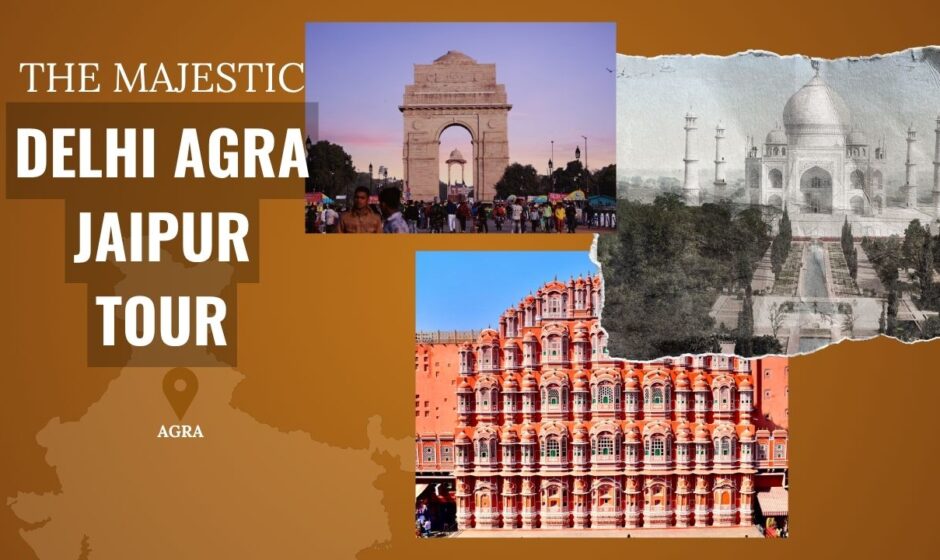India’s most iconic travel route, the Delhi Agra Jaipur tour, is a journey through the cultural, architectural, and historical soul of North India. Often called the “Golden Triangle,” this route connects three remarkable cities, each with its own character and heritage. Whether you’re drawn to Mughal marvels, Rajput grandeur, or vibrant street life, this tour gives a deep and rewarding glimpse into the diversity of India.
In this guide, we walk through each part of the Delhi Agra Jaipur tour—highlighting what makes it unforgettable, what you shouldn’t miss, and how to make the most of your time.
Start in Delhi: Where Old and New Coexist
Delhi, the capital city of India, is the first stop on the Delhi Agra Jaipur tour. It’s a city of contrasts—where ancient history meets modern hustle. The charm of Delhi lies in how easily it lets you time-travel from Mughal-era monuments to contemporary cafes, all in a day.
What to See in Delhi
-
Red Fort: A 17th-century Mughal fortress that tells stories of India’s imperial past.
-
Jama Masjid: Among the largest mosques in India, known for its imposing domes and minarets.
-
Qutub Minar: A UNESCO World Heritage Site and a brilliant example of Indo-Islamic architecture.
-
Humayun’s Tomb: This is often seen as the inspiration behind the Taj Mahal.
-
India Gate and Rashtrapati Bhavan: Symbols of modern Indian history and governance.
-
Lotus Temple: A modern-day marvel known for its flower-like design and peaceful ambiance.
Local Experience
While monuments are important, Delhi’s real flavor lies in its lanes and bazaars. A walk through Chandni Chowk offers street food, narrow alleyways, spice markets, and centuries-old shops. Meanwhile, Connaught Place provides a taste of British-era architecture and urban shopping.
Agra: The Mughal Marvel
Just a few hours from Delhi, Agra is home to the iconic Taj Mahal and a central highlight of the Delhi Agra Jaipur tour. But beyond this famous monument, the city holds other gems from the era of Mughal emperors.
Top Attractions in Agra
-
Taj Mahal: Built by Shah Jahan in memory of his wife Mumtaz Mahal, it is widely regarded as the ultimate symbol of love. It’s best visited early in the morning to avoid crowds and experience its changing hues.
-
Agra Fort: A UNESCO-listed site that served as the royal residence of Mughal emperors. The fort offers a view of the Taj from a distance and a look into royal life.
-
Itimad-ud-Daulah (also called the Baby Taj): A beautiful tomb that pre-dates the Taj Mahal and influenced its design.
-
Mehtab Bagh: A garden across the Yamuna River, ideal for photography and sunset views of the Taj.
What Makes Agra Special
Agra isn’t just about monuments; the craftsmanship here is worth attention. The city is known for marble inlay work, leather goods, and Mughlai cuisine. Try petha, a sweet delicacy, and visit the local markets like Sadar Bazaar for shopping.
Jaipur: The Royal Touch
The last stop in the Delhi Agra Jaipur tour is Jaipur, the capital of Rajasthan. Known as the “Pink City,” it’s famous for its historic forts, royal palaces, and lively markets. Jaipur brings a different energy—colorful, festive, and rooted in Rajput traditions.
Must-Visit Places in Jaipur
-
Amber Fort: Located on a hill, this fort is known for its artistic Hindu-style elements and elephant rides up to the gate.
-
City Palace: A blend of Rajasthani and Mughal architecture, still partly used by the royal family.
-
Hawa Mahal: The “Palace of Winds” is an iconic pink sandstone structure with hundreds of small windows.
-
Jantar Mantar: An astronomical observatory that’s ahead of its time.
-
Nahargarh Fort: Ideal for panoramic views of the city and a peaceful break from the busy streets.
Cultural Experience
What sets Jaipur apart is its craft and lifestyle. The city is a hub for block printing, blue pottery, gemstones, and traditional jewelry. You can also enjoy Rajasthani folk dances, puppet shows, and local cuisine like dal baati churma and gatte ki sabzi.
Travel Route and Duration Suggestions
The Delhi Agra Jaipur tour is usually planned for 5 to 7 days. Here’s a basic outline:
-
Day 1–2: Delhi – Monuments, local shopping, and food.
-
Day 3: Drive to Agra (Approx. 4 hours) – Taj Mahal and Agra Fort.
-
Day 4: Fatehpur Sikri en route to Jaipur – Visit this deserted Mughal city, then head to Jaipur.
-
Day 5–6: Jaipur – Forts, palaces, local culture, and shopping.
-
Day 7: Return to Delhi (or extend your trip to nearby places like Ranthambore or Pushkar).
This route is well-connected by road, rail, and now even luxury train options like the Palace on Wheels. Private cabs or guided tours make it more convenient.
Ideal Time for the Delhi Agra Jaipur Tour
The best time for this circuit is between October and March, when the weather is cooler. Summers (April to June) can be extremely hot, especially in Jaipur. Monsoon season (July to September) brings some greenery but also unpredictable weather.
Accommodation Options
All three cities offer a wide range of accommodations:
-
Delhi: From luxury hotels like The Imperial and ITC Maurya to budget options in Paharganj or Karol Bagh.
-
Agra: Taj-facing luxury hotels like The Oberoi Amarvilas, as well as budget-friendly stays near the east gate.
-
Jaipur: Choose from royal heritage hotels like Samode Haveli, or mid-range hotels in the city center.
For an authentic experience, heritage stays in Jaipur or Agra are highly recommended. These properties often offer royal décor, traditional food, and a peek into old Indian hospitality.
Food You Shouldn’t Miss
Each stop on the Delhi Agra Jaipur tour brings its own cuisine.
-
Delhi: Butter chicken, chole bhature, parathas at Paranthe Wali Gali.
-
Agra: Mughlai dishes, kebabs, and petha.
-
Jaipur: Rajasthani thali, laal maas, and sweets like ghewar.
Street food is also a big part of the journey, so don’t shy away from trying local snacks at recommended places.
Local Shopping Guide
Your Delhi Agra Jaipur tour would be incomplete without some local shopping:
-
Delhi: Dilli Haat and Sarojini Nagar for handicrafts and streetwear.
-
Agra: Marble souvenirs, leather items, and carpets.
-
Jaipur: Hand-block printed textiles, juttis, gemstones, and blue pottery.
Always bargain, especially in local bazaars. Many artisans also offer studio visits where you can see how the crafts are made.
Travel Tips for a Smooth Tour
-
Start early in the day to beat the crowd at monuments.
-
Carry light cotton clothes, a hat, and sunscreen.
-
Pre-book entry tickets online where possible to avoid long queues.
-
Keep cash and cards—some smaller markets may not accept digital payments.
-
Respect local customs, especially when visiting religious places.
-
Hiring a local guide can make the experience more meaningful.
Final Thoughts
The Delhi Agra Jaipur tour offers a layered look at India—its empires, traditions, cities, and people. From the Red Fort to the Taj Mahal to Jaipur’s majestic forts, the journey captures the essence of North India. It’s not just about visiting monuments—it’s about experiencing rhythm, color, and contrasts.
Whether you’re a first-time traveler or someone revisiting India, this triangle of cities continues to captivate. The route is time-tested, meaningful, and packed with memories waiting to happen.



